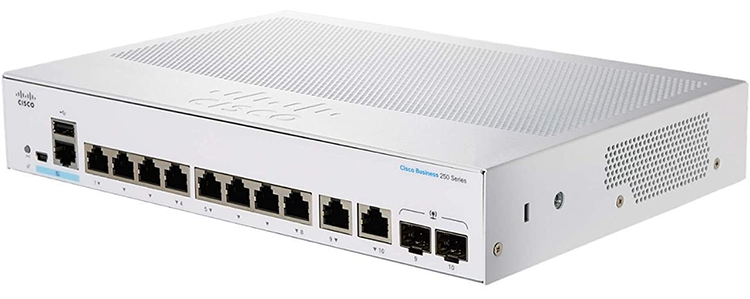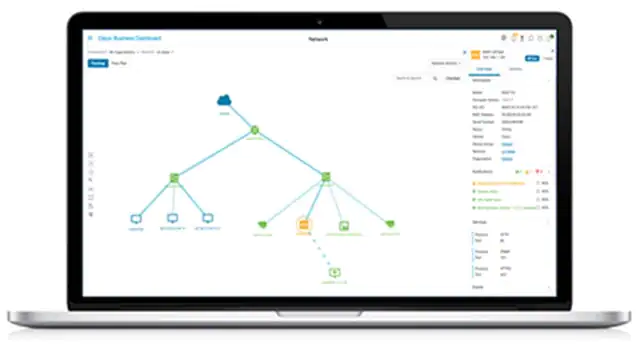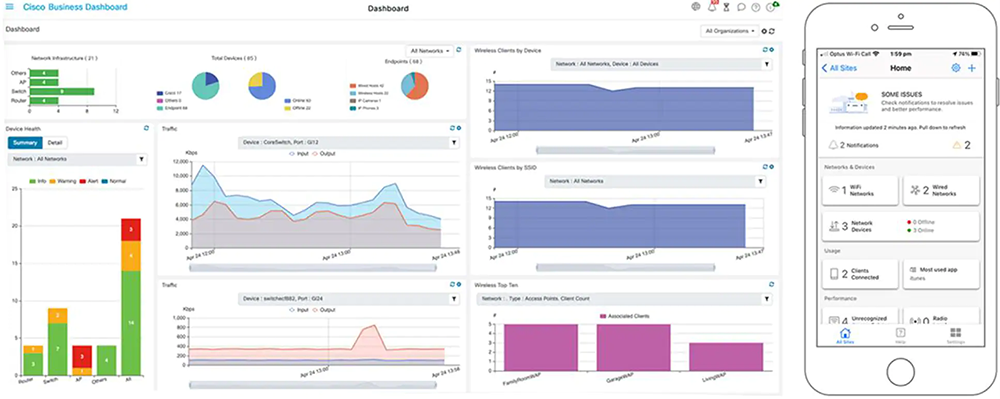
Cisco Business CBS250-8T-E-2G Discontinued
8-port Gigabit Ethernet Smart Switch with 2 Gigabit Copper/SFP Combo Ports

This product is no longer supported by Cisco.
We recommend transitioning to the new Catalyst 1200 8-port Smart Switch. These switches offer advanced features and pervasive security, managed conveniently through the Cisco Business Dashboard and mobile app.
Cisco Business 250 Series Smart Switches Status:
- End-of-Sale Date: October 29, 2024
- End-of-Support Date: October 31, 2029
Overview:
Build a reliable, easy-to-use business network at an affordable price
From connectivity to cloud applications, networking plays a crucial role in every business journey. Reliability, security, and affordability continue to be top of mind while ongoing management and operations add additional complexity that take time and resources.
Cisco Business is a portfolio of affordable wireless access points, switches and routers designed and built for Small Business. Managed through Cisco Business Dashboard and mobile app, the portfolio provides a simple and reliable experience. Cisco Business Dashboard simplifies traditional challenges in deploying and managing business networks by automating the deployment, monitoring and lifecycle management of the network.
The Cisco Business 250 Series is the next generation of affordable smart switches that combine powerful performance and reliability with a complete suite of the features you need for a solid business network. These switches provide flexible management options, comprehensive security capabilities and Layer 3 static routing features far beyond those of an unmanaged or consumer-grade switch, at a lower cost than for fully managed switches. When you need a reliable solution to share online resources and connect computers, phones, and wireless access points, Cisco Business 250 Series Smart Switches provide the ideal solution at an affordable pricing point.

Flexibility
Get 8 to 48 ports of Gigabit Ethernet connectivity, GE or 10-GE uplinks, and PoE+ support.

Simplicity
Plug and play with existing voice, wireless, data, video, and connected networking devices.

Performance
Provide additional fiber connectivity for higher uplink bandwidth and expanded options with more PoE power budget.

Security
Integrated security helps to prevent unauthorized access and protects your business data.

Business Applications
Whether you need basic, high-speed connectivity for your computers and servers or a comprehensive voice, data, and wireless technology solution, Cisco Business 250 Series switches can meet your business needs. Possible deployment scenarios include:
- High-speed desktop connectivity: Cisco Business 250 Series switches can quickly and securely connect employees working in small offices with one another and with all of the printers, servers, and other networking devices. High performance and reliable connectivity help speed up file transfers and data processing, improve network uptime, and keep your employees productive.
- Flexible wireless connectivity: Cisco Business 250 Series switches work with Cisco and third-party wireless solutions to extend the reach of your network. With security features, Power over Ethernet Plus (PoE+), Virtual Local Area Network (VLAN), and QoS, these switches are the perfect foundation to add enterprise-grade wireless solutions to a network. The capability of up to 30W of power per port provided through the Ethernet cable means you can easily deploy Cisco Business Wireless access points to maximize workforce productivity.
- Unified communications: The Cisco Business 250 Series provides QoS features to enable you to prioritize delay-sensitive traffic in your network and let you converge all of your communications solutions such as IP telephony and video surveillance onto a single Ethernet network. Cisco offers a complete portfolio of IP telephony and other unified communications products designed for small businesses, and Cisco 250 Series switches have been rigorously tested to help ensure easy integration and full compatibility with these and other vendor products.

Cisco Business Dashboard
Cisco Business Dashboard makes managing a business network easy by automating the deployment, monitoring, and lifecycle management of Cisco Business switches, routers, and wireless access points.

Cisco Business Dashboard and Cisco Business mobile app
Features and Benefits:
Cisco Business 250 Series Smart Switches provide all of the features you need to create a basic enterprise-class network at an affordable price. These features include:
Easy Configuration and Management
Cisco Business 250 Series switches are designed to be easy to deploy and use by small businesses or the partners that serve them:
- Cisco Business Dashboard is designed to manage Cisco Business switches, routers, and wireless access points. It lets you easily customize the interface and widgets to proactively manage your network. Cisco Business 250 Series switches support embedded probe for Cisco Business Dashboard, eliminating the need to set up a separate hardware or virtual machine on site.
- The Cisco Network Plug and Play solution provides a simple, secure, unified, and integrated offering to ease new device rollouts or for provisioning updates to an existing network. The solution provides a unified approach to provision Cisco routers, switches, and wireless devices with a near-zero-touch deployment experience.
- The redesigned modern web user interfaces reduce the time required to deploy, troubleshoot, and manage the network. Configuration wizards simplify the most common configuration tasks and provide the ultimate tool for anyone to set up and manage the network.
Reliability and Performance
Cisco Business 250 Series switches have been tested to deliver the high performance and reliability you would expect from a Cisco switch and help you prevent costly downtime. The switches speed file transfer times, improve slow and sluggish networks, keep your vital business applications available, and help your employees respond more quickly to customers and each other. With a network based on Cisco Business 250 Series switches, you can address all of your business communications and connectivity needs and reduce the total cost of ownership of your technology infrastructure. Cisco Business 250 Series switches also support 10 Gigabit Ethernet uplinks on select models, so you can build a high-performance and future-ready network to support your thriving business.
Layer 3 Static Routing
This capability allows you to segment your network into separate workgroups and communicate across VLANs without degrading application performance. As a result, you can manage internal routing with your switches and dedicate your router to external traffic and security, helping your network run more efficiently.
Power over Ethernet (PoE)
Cisco Business 250 Series switches are available with PoE+ on Gigabit Ethernet models. This capability enables the deployment of IP telephony, wireless, video surveillance, and other solutions with just a single network cable, thereby eliminating the need for separate power supplies or cabling. PoE+ provides up to 30W of power per port, ideal for deployments of 802.11ac wireless access points, Pan-Tilt-Zoom (PTZ) IP cameras, videophones, and thin client devices, delivering more flexibility and investment protection.
Network Security
Cisco Business 250 Series switches provide the security and network management features you need to maintain a high level of security for your business, keep unauthorized users off the network, and protect your business data. The switches include integrated network security to reduce the risk of a security breach, with IEEE 802.1X port security to control access to your network, Denial-of-Service (DoS) attack prevention to increase network uptime during an attack, and extensive Access Control Lists (ACLs) to protect sensitive portions of the network from unauthorized users and guard against network attacks.
Flexible and Compact Design
The sleek and compact design provide additional deployment flexibility, including outside wiring closet installation such as retail stores, open plan offices, and classrooms without disturbing the environment.
An Energy-Efficient Solution
Cisco Business 250 Series switches are designed to be energy efficient and eco-friendly without compromising performance. They help conserve energy by optimizing power use, which helps protect the environment and lowers your energy costs. Power-saving features include:
- Support for the Energy Efficient Ethernet (IEEE 802.3az) standard, which reduces energy consumption by monitoring the amount of traffic on an active link and putting the link into a sleep state during quiet periods
- Automatic power shutoff on ports when a link is down
- Fan-less design in most models, which reduces power consumption, increases reliability, and provides quieter operation
Peace of Mind and Investment Protection
Cisco Business 250 Series switches offer the reliable performance, investment protection, and peace of mind you expect from a Cisco switch. Complementary one-year access to our Small Business Support Center for ongoing support. Limited lifetime warranty with return to factory replacement keeps your business running smoothly.
Technical Specifications:
| Cisco Business 250 Series Gigabit Ethernet Switches Specifications | ||||
|---|---|---|---|---|
| Performance | ||||
| Switching capacity and forwarding rate | Model | Capacity in millions of packets per second (64-byte packets) | Switching capacity in gigabits per second | |
| CBS250-8T-E-2G | 14.88 mpps | 20.0 Gbps | ||
| CBS250-8PP-E-2G | 14.88 mpps | 20.0 Gbps | ||
| CBS250-8P-E-2G | 14.88 mpps | 20.0 Gbps | ||
| CBS250-8FP-E-2G | 14.88 mpps | 20.0 Gbps | ||
| CBS250-16T-2G | 26.78 mpps | 36.0 Gbps | ||
| CBS250-16P-2G | 26.78 mpps | 36.0 Gbps | ||
| CBS250-24T-4G | 41.66 mpps | 56.0 Gbps | ||
| CBS250-24PP-4G | 41.66 mpps | 56.0 Gbps | ||
| CBS250-24P-4G | 41.66 mpps | 56.0 Gbps | ||
| CBS250-24FP-4G | 41.66 mpps | 56.0 Gbps | ||
| CBS250-48T-4G | 77.38 mpps | 104.0 Gbps | ||
| CBS250-48PP-4G | 77.38 mpps | 104.0 Gbps | ||
| CBS250-48P-4G | 77.38 mpps | 104.0 Gbps | ||
| Layer 2 switching | ||||
| Spanning Tree Protocol (STP) | Standard 802.1d spanning tree support Fast convergence using 802.1w (Rapid Spanning Tree Protocol [RSTP]), enabled by default Multiple spanning tree instances using 802.1s (MSTP); 8 instances are supported Per-VLAN Spanning Tree Plus (PVST+); 126 instances are supported Rapid PVST+ (RPVST+); 126 instances are supported |
|||
| Port grouping/link aggregation | Support for IEEE 802.3ad Link Aggregation Control Protocol (LACP)
|
|||
| VLAN | Support for up to 255 active VLANs simultaneously Port-based and 802.1Q tag-based VLANs Management VLAN Guest VLAN |
|||
| Voice VLAN | Voice traffic is automatically assigned to a voice-specific VLAN and treated with appropriate levels of QoS. Auto voice capabilities deliver networkwide zero-touch deployment of voice endpoints and call control devices | |||
| Generic VLAN Registration Protocol (GVRP) and Generic Attribute Registration Protocol (GARP) | Protocols for automatically propagating and configuring VLANs in a bridged domain | |||
| IGMP (versions 1, 2, and 3) snooping | Internet Group Management Protocol (IGMP) limits bandwidth-intensive multicast traffic to only the requesters; supports 255 multicast groups (source-specific multicasting is also supported) | |||
| IGMP querier | Used to support a Layer 2 multicast domain of snooping switches in the absence of a multicast router | |||
| HOL blocking | Head-of-Line (HOL) blocking prevention | |||
| Loopback detection | Provides protection against loops by transmitting loop protocol packets out of ports on which loop protection has been enabled. It operates independently of STP. | |||
| Layer 3 routing | ||||
| IPv4 routing | Wire-speed routing of IPv4 packets Up to 32 static routes and up to 16 IP interfaces |
|||
| IPv6 routing | Wire-speed routing of IPv6 packets | |||
| Layer 3 interface | Configuration of Layer 3 interface on physical port, LAG, VLAN interface, or loopback interface | |||
| Classless Interdomain Routing (CIDR) | Support for CIDR | |||
| Dynamic Host Configuration Protocol (DHCP) relay at Layer 3 | Relay of DHCP traffic across IP domains | |||
| User Datagram Protocol (UDP) relay | Relay of broadcast information across Layer 3 domains for application discovery or relaying of Bootstrap Protocol (BootP)/DHCP packets | |||
| Security | ||||
| Secure Sockets Layer (SSL) | SSL encrypts all HTTPS traffic, allowing secure access to the browser-based management GUI in the switch | |||
| Secure Shell (SSH) Protocol | SSH is a secure replacement for Telnet traffic. Secure Copy (SCP) also uses SSH. SSH v1 and v2 are supported. | |||
| IEEE 802.1X (authenticator role) | Remote Authentication Dial-In User Service (RADIUS) authentication, guest VLAN, single/multiple host mode, and single/multiple sessions | |||
| STP loopback guard | Provides additional protection against Layer 2 forwarding loops (STP loops) | |||
| Secure Core Technology (SCT) | Ensures that the switch will receive and process management and protocol traffic no matter how much traffic is received | |||
| Secure Sensitive Data (SSD) | A mechanism to manage sensitive data (such as passwords, keys, and so on) securely on the switch, populating this data to other devices, and secure autoconfig. Access to view the sensitive data as plain text or encrypted is provided according to the user-configured access level and the access method of the user | |||
| Trustworthy systems | Trustworthy systems provide a highly secure foundation for Cisco products Run-time defenses (Executable Space Protection [X-Space], Address Space Layout Randomization [ASLR], Built-In Object Size Checking [BOSC]) |
|||
| Port security | Ability to lock source MAC addresses to ports and limit the number of learned MAC addresses | |||
| RADIUS | Supports RADIUS authentication for management access. Switch functions as a client. | |||
| Storm control | Broadcast, multicast, and unknown unicast | |||
| DoS prevention | Denial-of-Service (DoS) attack prevention | |||
| Multiple user privilege levels in CLI | Level 1, 7, and 15 privilege levels | |||
| Access Control Lists (ACLs) | Support for up to 512 rules Drop or rate limit based on source and destination MAC, VLAN ID or IPv4 or IPv6 address, IPv6 flow label, protocol, port, Differentiated Services Code Point (DSCP)/IP precedence, TCP/UDP source and destination ports, 802.1p priority, Ethernet type, Internet Control Message Protocol (ICMP) packets, IGMP packets, TCP flag; ACL can be applied on both ingress and egress sides Time-based ACLs supported |
|||
| Quality of service | ||||
| Priority levels | 8 hardware queues | |||
| Scheduling | Strict priority and Weighted Round-Robin (WRR) queue assignment based on DSCP and class of service (802.1p/CoS) | |||
| Class of service | Port based; 802.1p VLAN priority based; IPv4/v6 IP precedence/Type of Service (ToS)/DSCP based; Differentiated Services (DiffServ); classification and re-marking ACLs, trusted QoS | |||
| Rate limiting | Ingress policer; egress shaping and rate control; per VLAN, per port, and flow based | |||
| Congestion avoidance | A TCP congestion avoidance algorithm is required to reduce and prevent global TCP loss synchronization | |||
| Standards | ||||
| Standards | IEEE 802.3 10BASE-T Ethernet, IEEE 802.3u 100BASE-TX Fast Ethernet, IEEE 802.3ab 1000BASE-T Gigabit Ethernet, IEEE 802.3ad Link Aggregation Control Protocol, IEEE 802.3z Gigabit Ethernet, IEEE 802.3x Flow Control, IEEE 802.3 ad LACP, IEEE 802.1D (STP), IEEE 802.1Q/p VLAN, IEEE 802.1w RSTP, IEEE 802.1s Multiple STP, IEEE 802.1X Port Access Authentication, IEEE 802.3af, IEEE 802.3at, RFC 768, RFC 783, RFC 791, RFC 792, RFC 793, RFC 813, RFC 879, RFC 896, RFC 826, RFC 854, RFC 855, RFC 856, RFC 858, RFC 894, RFC 919, RFC 920, RFC 922, RFC 950, RFC 951, RFC 1042, RFC 1071, RFC 1123, RFC 1141, RFC 1155, RFC 1157, RFC 1213, RFC 1215, RFC 1286, RFC 1350, RFC 1442, RFC 1451, RFC 1493, RFC 1533, RFC 1541, RFC 1542, RFC 1573, RFC 1624, RFC 1643, RFC 1700, RFC 1757, RFC 1867, RFC 1907, RFC 2011, RFC 2012, RFC 2013, RFC 2030, RFC 2131, RFC 2132, RFC 2233, RFC 2576, RFC 2616, RFC 2618, RFC 2665, RFC 2666, RFC 2674, RFC 2737, RFC 2819, RFC 2863, RFC 3164, RFC 3411, RFC 3412, RFC 3413, RFC 3414, RFC 3415, RFC 3416, RFC 4330 | |||
| IPv6 | ||||
| IPv6 | IPv6 host mode IPv6 over Ethernet Dual IPv6/IPv4 stack IPv6 Neighbor Discovery (ND) IPv6 stateless address auto configuration Path Maximum Transmission Unit (MTU) discovery Duplicate Address Detection (DAD) Internet Control Message Protocol (ICMP) version 6 IPv6 over IPv4 network with Intrasite Automatic Tunnel Addressing Protocol (ISATAP) support USGv6 and IPv6 Gold Logo certified |
|||
| IPv6 QoS | Prioritize IPv6 packets in hardware | |||
| IPv6 ACL | Drop or rate limit IPv6 packets in hardware | |||
| Multicast Listener Discovery (MLD v1/2) snooping | Deliver IPv6 multicast packets only to the required receivers | |||
| IPv6 applications | Web/SSL, Telnet server/SSH, Ping, Traceroute, Simple Network Time Protocol (SNTP), Trivial File Transfer Protocol (TFTP), Simple Network Management Protocol (SNMP), Remote Authentication Dial-In User Service (RADIUS), Syslog, DNS client, DHCP client, DHCP autoconfig | |||
| IPv6 RFCs supported | RFC 4443 (which obsoletes RFC 2463): ICMPv6 RFC 4291 (which obsoletes RFC 3513): IPv6 address architecture RFC 4291: IPv6 Addressing Architecture RFC 2460: IPv6 Specification RFC 4861 (which obsoletes RFC 2461): Neighbor Discovery for IPv6 RFC 4862 (which obsoletes RFC 2462): IPv6 Stateless Address Autoconfiguration RFC 1981: Path MTU Discovery RFC 4007: IPv6 Scoped Address Architecture RFC 3484: Default address selection mechanism RFC 5214 (which obsoletes RFC 4214): ISATAP tunneling RFC 4293: Management Information Base (MIB) IPv6: Textual Conventions and General Group RFC 3595: Textual Conventions for IPv6 Flow Label |
|||
| Management | ||||
| Cisco Business Dashboard | Support for embedded probe for Cisco Business Dashboard running on the switch. Eliminates the need to set up a separate hardware or virtual machine for the Cisco Business Dashboard Probe on site. | |||
| Cisco Business mobile app | Mobile app for Cisco Business Switch and Wireless products. Helps to set up a local network in minutes and provide easy management at your fingertips. | |||
| Cisco Network Plug and Play (PnP) agent | The Cisco Network Plug and Play solution provides a simple, secure, unified, and integrated offering to ease new branch or campus device rollouts or for provisioning updates to an existing network. The solution provides a unified approach to provision Cisco routers, switches, and wireless devices with a near-zero-touch deployment experience. Supports Cisco PnP Connect |
|||
| Web user interface | Built-in switch configuration utility for easy browser-based device configuration (HTTP/HTTPS). Supports configuration, wizards, system dashboard, system maintenance, and monitoring Basic and advanced mode for maximum operational efficiency |
|||
| SNMP | SNMP versions 1, 2c, and 3 with support for traps, and SNMP v3 User-based Security Model (USM) | |||
| Standard MIBs | lldp-MIB lldpextdot1-MIB lldpextdot3-MIB lldpextmed-MIB rfc2674-MIB rfc2575-MIB rfc2573-MIB rfc2233-MIB rfc2013-MIB rfc2012-MIB rfc2011-MIB RFC-1212 RFC-1215 SNMPv2-CONF SNMPv2-TC p-bridge-MIB q-bridge-MIB rfc1389-MIB rfc1493-MIB rfc1611-MIB rfc1612-MIB rfc1850-MIB rfc1907-MIB rfc2571-MIB rfc2572-MIB rfc2574-MIB rfc2576-MIB rfc2613-MIB rfc2665-MIB |
rfc2668-MIB rfc2737-MIB rfc2925-MIB rfc3621-MIB rfc4668-MIB rfc4670-MIB trunk-MIB tunnel-MIB udp-MIB draft-ietf-bridge-8021x-MIB draft-ietf-bridge-rstpmib-04-MIB draft-ietf-hubmib-etherif-mib-v3-00-MIB draft-ietf-syslog-device-MIB ianaaddrfamnumbers-MIB ianaifty-MIB ianaprot-MIB inet-address-MIB ip-forward-MIB ip-MIB RFC1155-SMI RFC1213-MIB SNMPv2-MIB SNMPv2-SMI SNMPv2-TM RMON-MIB rfc1724-MIB dcb-raj-DCBX-MIB-1108-MIB rfc1213-MIB rfc1757-MIB |
||
| Private MIBs | CISCOSB-lldp-MIB CISCOSB-brgmulticast-MIB CISCOSB-bridgemibobjects-MIB CISCOSB-bonjour-MIB CISCOSB-dhcpcl-MIB CISCOSB-MIB CISCOSB-wrandomtaildrop-MIB CISCOSB-traceroute-MIB CISCOSB-telnet-MIB CISCOSB-stormctrl-MIB CISCOSBssh-MIB CISCOSB-socket-MIB CISCOSB-sntp-MIB CISCOSB-smon-MIB CISCOSB-phy-MIB CISCOSB-multisessionterminal-MIB CISCOSB-mri-MIB CISCOSB-jumboframes-MIB CISCOSB-gvrp-MIB CISCOSB-endofmib-MIB CISCOSB-dot1x-MIB CISCOSB-deviceparams-MIB CISCOSB-cli-MIB CISCOSB-cdb-MIB CISCOSB-brgmacswitch-MIB CISCOSB-3sw2swtables-MIB CISCOSB-smartPorts-MIB CISCOSB-tbi-MIB CISCOSB-macbaseprio-MIB CISCOSB-env_mib-MIB CISCOSB-policy-MIB CISCOSB-sensor-MIB CISCOSB-aaa-MIB CISCOSB-application-MIB CISCOSB-bridgesecurity-MIB CISCOSB-copy-MIB CISCOSB-CpuCounters-MIB CISCOSB-Custom1BonjourService-MIB CISCOSB-dhcp-MIB CISCOSB-dlf-MIB CISCOSB-dnscl-MIB CISCOSB-embweb-MIB CISCOSB-fft-MIB CISCOSB-file-MIB CISCOSB-greeneth-MIB CISCOSB-interfaces-MIB CISCOSB-interfaces_recovery-MIB |
CISCOSB-ip-MIB CISCOSB-iprouter-MIB CISCOSB-ipv6-MIB CISCOSB-mnginf-MIB CISCOSB-lcli-MIB CISCOSB-localization-MIB CISCOSB-mcmngr-MIB CISCOSB-mng-MIB CISCOSB-physdescription-MIB CISCOSB-PoE-MIB CISCOSB-protectedport-MIB CISCOSB-rmon-MIB CISCOSB-rs232-MIB CISCOSB-SecuritySuite-MIB CISCOSB-snmp-MIB CISCOSB-specialbpdu-MIB CISCOSB-banner-MIB CISCOSB-syslog-MIB CISCOSB-TcpSession-MIB CISCOSB-traps-MIB CISCOSB-trunk-MIB CISCOSB-tuning-MIB CISCOSB-tunnel-MIB CISCOSB-udp-MIB CISCOSB-vlan-MIB CISCOSB-ipstdacl-MIB CISCOSB-eee-MIB CISCOSB-ssl-MIB CISCOSB-qosclimib-MIB CISCOSB-digitalkeymanage-MIB CISCOSB-tbp-MIB CISCOSMB-MIB CISCOSB-secsd-MIB CISCOSB-draft-ietf-entmib-sensor-MIB CISCOSB-draft-ietf-syslog-device-MIB CISCOSB-rfc2925-MIB CISCO-SMI-MIB CISCOSB-DebugCapabilities-MIB CISCOSB-CDP-MIB CISCOSB-vlanVoice-MIB CISCOSB-EVENTS-MIB CISCOSB-sysmng-MIB CISCOSB-sct-MIB CISCO-TC-MIB CISCO-VTP-MIB CISCO-CDP-MIB |
||
| Remote monitoring (RMON) | Embedded RMON software agent supports 4 RMON groups (history, statistics, alarms, and events) for enhanced traffic management, monitoring, and analysis | |||
| IPv4 and IPv6 dual stack | Coexistence of both protocol stacks to ease migration | |||
| Firmware upgrade | Web browser upgrade (HTTP/HTTPS) and TFTP and upgrade over SCP running over SSH Dual images for resilient firmware upgrades |
|||
| Port mirroring | Traffic on a port can be mirrored to another port for analysis with a network analyzer or RMON probe. Up to 4 source ports can be mirrored to one destination port | |||
| VLAN mirroring | Traffic from a VLAN can be mirrored to a port for analysis with a network analyzer or RMON probe. Up to 4 source VLANs can be mirrored to one destination port | |||
| Dynamic Host Configuration Protocol (DHCP) (options 12, 66, 67, 129, and 150) | DHCP options facilitate tighter control from a central point (DHCP server), to obtain IP address, autoconfiguration (with configuration file download), DHCP Relay, and host name | |||
| Secure Copy (SCP) | Securely transfers files to and from the switch | |||
| Autoconfiguration with SCP file download | Enables mass deployment with protection of sensitive data | |||
| Text-editable configs | Config files can be edited with a text editor and downloaded to another switch, facilitating easier mass deployment | |||
| Smartports | Simplified configuration of QoS and security capabilities | |||
| Auto Smartports | Automatically applies the intelligence delivered through the Smartports roles to the port based on the devices discovered over Cisco Discovery Protocol or LLDP-MED. This facilitates zero-touch deployments. | |||
| Text view Command-Line Interface (CLI) | Scriptable CLI. A full CLI as well as a menu-based CLI is supported. User privilege levels 1, 7, and 15 are supported for the CLI. | |||
| Localization | Localization of GUI and documentation into multiple languages | |||
| Login banner | Configurable multiple banners for web as well as CLI | |||
| Other management | Traceroute; single IP management; HTTP/HTTPS; RADIUS; port mirroring; TFTP upgrade; DHCP client; Simple Network Time Protocol (SNTP); cable diagnostics; Ping; syslog; Telnet client (SSH secure support); automatic time settings from Management Station | |||
| Green (power efficiency) | ||||
| Energy detect | Automatically turns power off on RJ-45 port when detecting link down. Active mode is resumed without loss of any packets when the switch detects the link is up | |||
| Cable length detection | Adjusts the signal strength based on the cable length. Reduces the power consumption for shorter cables | |||
| EEE compliant (802.3az) | Supports IEEE 802.3az on all copper Gigabit Ethernet ports | |||
| Disable port LEDs | LEDs can be manually turned off to save on energy | |||
| Time-based port operation | Link up or down based on user-defined schedule (when the port is administratively up) | |||
| Time-based PoE | PoE power can be on or off based on user-defined schedule to save energy | |||
| General | ||||
| Jumbo frames | Frame sizes up to 9K bytes. The default MTU is 2K bytes | |||
| MAC table | 8K addresses | |||
| Discovery | ||||
| Bonjour | The switch advertises itself using the Bonjour protocol | |||
| Link Layer Discovery Protocol (LLDP) (802.1ab) with LLDP-MED extensions | Link Layer Discovery Protocol (LLDP) allows the switch to advertise its identification, configuration, and capabilities to neighboring devices that store the data in a MIB. LLDP-MED is an enhancement to LLDP that adds the extensions needed for IP phones | |||
| Cisco Discovery Protocol | The switch advertises itself using the Cisco Discovery Protocol. It also learns the connected device and its characteristics using Cisco Discovery Protocol | |||
| Power over Ethernet (PoE) | ||||
| 802.3at PoE+ and 802.3af PoE delivered over any of the RJ-45 ports within the listed power budgets | The following switches support 802.3at PoE+, 802.3af, and Cisco prestandard (legacy) PoE. Maximum power of 30.0W to any 10/100 or Gigabit Ethernet port, until the PoE budget for the switch is reached. The total power available for PoE per switch is as follows: | |||
| Model | Power dedicated to PoE | Number of ports that support PoE | ||
| CBS250-8PP-E-2G | 45W | 8 | ||
| CBS250-8P-E-2G | 60W | 8 | ||
| CBS250-8FP-E-2G | 120W | 8 | ||
| CBS250-16P-2G | 120W | 16 | ||
| CBS250-24PP-4G | 100W | 24 | ||
| CBS250-24P-4G | 195W | 24 | ||
| CBS250-24FP-4G | 370W | 24 | ||
| CBS250-48PP-4G | 195W | 48 | ||
| CBS250-48P-4G | 370W | 48 | ||
| Power consumption (worst case) | Model | System power consumption | Power consumption (with PoE) | Heat dissipation (BTU/hr) |
| CBS250-8T-E-2G | 110V=12.55W 220V=12.56W |
N/A | 42.86 | |
| CBS250-8PP-E-2G | 110V=14.34W 220V=14.47W |
110V=65.29W 220V=66.02W |
222.79 | |
| CBS250-8P-E-2G | 110V=13.84W 220V=14.31W |
110V=80.79W 220V=80.86W |
275.91 | |
| CBS250-8FP-E-2G | 110V=17.07W 220V=16.68W |
110V=147.48W 220V=145.26W |
503.22 | |
| CBS250-16T-2G | 110V=18.63W 220V=18.37W |
N/A | 64.46 | |
| CBS250-16P-2G | 110V=24.51W 220V=25.01W |
110V=156.4W 220V=154.5W |
536.05 | |
| CBS250-24T-4G | 110V=25.91W 220V=25.63W |
N/A | 89.13 | |
| CBS250-24PP-4G | 110V=34.4W 220V=33.11W |
110V=138.9W 220V=138.1W |
476.68 | |
| CBS250-24P-4G | 110V=34.42W 220V=33.09W |
110V=239.7W 220V=236.4W |
820.28 | |
| CBS250-24FP-4G | 110V=46.60W 220V=46.35W |
110V=449.7W 220V=438.3W |
1,536.83 | |
| CBS250-48T-4G | 110V=48.27W 220V=48.64W |
N/A | 165.96 | |
| CBS250-48PP-4G | 110V=68.68W 220V=67.18W |
110V=276.75W 220V=270.58W |
944.31 | |
| CBS250-48P-4G | 110V=60.77W 220V=59.73W |
110V=451.95W 220V=445.85W |
1,542.12 | |
| Ports | Model name | Total system ports | RJ-45 ports | Combo ports (RJ-45 + SFP) |
| CBS250-8T-E-2G | 10 Gigabit Ethernet | 8 Gigabit Ethernet | 2 Gigabit Ethernet combo | |
| CBS250-8PP-E-2G | 10 Gigabit Ethernet | 8 Gigabit Ethernet | 2 Gigabit Ethernet combo | |
| CBS250-8P-E-2G | 10 Gigabit Ethernet | 8 Gigabit Ethernet | 2 Gigabit Ethernet combo | |
| CBS250-8FP-E-2G | 10 Gigabit Ethernet | 8 Gigabit Ethernet | 2 Gigabit Ethernet combo | |
| CBS250-16T-2G | 18 Gigabit Ethernet | 16 Gigabit Ethernet | 2 Small Form-Factor Pluggable (SFP) | |
| CBS250-16P-2G | 18 Gigabit Ethernet | 16 Gigabit Ethernet | 2 SFP | |
| CBS250-24T-4G | 28 Gigabit Ethernet | 24 Gigabit Ethernet | 4 SFP | |
| CBS250-24PP-4G | 28 Gigabit Ethernet | 24 Gigabit Ethernet | 4 SFP | |
| CBS250-24P-4G | 28 Gigabit Ethernet | 24 Gigabit Ethernet | 4 SFP | |
| CBS250-24FP-4G | 28 Gigabit Ethernet | 24 Gigabit Ethernet | 4 SFP | |
| CBS250-48T-4G | 52 Gigabit Ethernet | 48 Gigabit Ethernet | 4 SFP | |
| CBS250-48PP-4G | 52 Gigabit Ethernet | 48 Gigabit Ethernet | 4 SFP | |
| CBS250-48P-4G | 52 Gigabit Ethernet | 48 Gigabit Ethernet | 4 SFP | |
| Console port | Cisco Standard mini USB Type-B/RJ45 console port* *Not available on CBS250-8T-D and CBS250-8PP-D |
|||
| USB slot | USB Type-A slot on the front panel of the switch for easy file and image management | |||
| Buttons | Reset button | |||
| Cabling type | Unshielded Twisted Pair (UTP) Category 5e or better for 1000BASE-T | |||
| LEDs | System, Link/Act, PoE, Speed | |||
| Flash | 256 MB | |||
| CPU | 800 MHz ARM | |||
| DRAM | 512 MB | |||
| Packet buffer | All numbers are aggregate across all ports because the buffers are dynamically shared: | |||
| Model name | Packet buffer | |||
| CBS250-8T-E-2G | 1.5 MB | |||
| CBS250-8PP-E-2G | 1.5 MB | |||
| CBS250-8P-E-2G | 1.5 MB | |||
| CBS250-8FP-E-2G | 1.5 MB | |||
| CBS250-16T-2G | 1.5 MB | |||
| CBS250-16P-2G | 1.5 MB | |||
| CBS250-24T-4G | 1.5 MB | |||
| CBS250-24PP-4G | 1.5 MB | |||
| CBS250-24P-4G | 1.5 MB | |||
| CBS250-24FP-4G | 1.5 MB | |||
| CBS250-48T-4G | 3 MB | |||
| CBS250-48PP-4G | 3 MB | |||
| CBS250-48P-4G | 3 MB | |||
| Supported SFP/SFP+ modules | SKU | Media | Speed | Maximum distance |
| MGBSX1 | Multimode fiber | 1000 Mbps | 500 m | |
| MGBLH1 | Single-mode fiber | 1000 Mbps | 40 km | |
| MGBLX1 | Single-mode fiber | 1000 Mbps | 10 km | |
| MGBT1 | UTP cat 5e | 1000 Mbps | 100 m | |
| GLC-SX-MMD | Multimode fiber | 1000 Mbps | 550 m | |
| GLC-LH-SMD | Single-mode fiber | 1000 Mbps | 10 km | |
| GLC-BX-U | Single-mode fiber | 1000 Mbps | 10 km | |
| GLC-BX-D | Single-mode fiber | 1000 Mbps | 10 km | |
| GLC-TE | UTP cat 5e | 1000 Mbps | 100 m | |
| SFP-H10GB-CU1M | Copper coax | 10 Gig | 1 m | |
| SFP-H10GB-CU3M | Copper coax | 10 Gig | 3 m | |
| SFP-H10GB-CU5M | Copper coax | 10 Gig | 5 m | |
| SFP-10G-SR | Multimode fiber | 10 Gig | 26 m - 400 m | |
| SFP-10G-LR | Single-mode fiber | 10 Gig | 10 km | |
| SFP-10G-SR-S | Multimode fiber | 10 Gig | 26 m - 400 m | |
| SFP-10G-LR-S | Single-mode fiber | 10 Gig | 10 km | |
| Environmental | ||||
| Unit dimensions (W x D x H) |
Model name | Unit dimensions | ||
| CBS250-8T-E-2G | 268 x 185 x 44 mm (10.56 x 7.28 x 1.73 in) | |||
| CBS250-8PP-E-2G | 268 x 185 x 44 mm (10.56 x 7.28 x 1.73 in) | |||
| CBS250-8P-E-2G | 268 x 185 x 44 mm (10.56 x 7.28 x 1.73 in) | |||
| CBS250-8FP-E-2G | 268 x 185 x 44 mm (10.56 x 7.28 x 1.73 in) | |||
| CBS250-16T-2G | 268 x 272 x 44 mm (10.56 x 10.69 x 1.73 in) | |||
| CBS250-16P-2G | 268 x 297 x 44 mm (10.56 x 11.69 x 1.73 in) | |||
| CBS250-24T-4G | 445 x 240 x 44 mm (17.5 x 9.45 x 1.73 in) | |||
| CBS250-24PP-4G | 445 x 299 x 44 mm (17.5 x 11.77 x 1.73 in) | |||
| CBS250-24P-4G | 445 x 299 x 44 mm (17.5 x 11.77 x 1.73 in) | |||
| CBS250-24FP-4G | 445 x 345 x 44 mm (17.5 x 13.59 x 1.73 in) | |||
| CBS250-48T-4G | 445 x 288 x 44 mm (17.5 x 11.33 x 1.73 in) | |||
| CBS250-48PP-4G | 445 x 350 x 44 mm (17.5 x 13.78 x 1.73 in) | |||
| CBS250-48P-4G | 445 x 350 x 44 mm (17.5 x 13.78 x 1.73 in) | |||
| Unit weight | Model name | Unit weight | ||
| CBS250-8T-E-2G | 1.39 kg (3.06 lb) | |||
| CBS250-8PP-E-2G | 1.53 kg (3.37 lb) | |||
| CBS250-8P-E-2G | 1.53 kg (3.37 lb) | |||
| CBS250-8FP-E-2G | 1.53 kg (3.37 lb) | |||
| CBS250-16T-2G | 1.78 kg (3.92 lb) | |||
| CBS250-16P-2G | 2.38 kg (5.25 lb) | |||
| CBS250-24T-4G | 2.63 kg (5.80 lb) | |||
| CBS250-24PP-4G | 3.53 kg (7.78 lb) | |||
| CBS250-24P-4G | 3.53 kg (7.78 lb) | |||
| CBS250-24FP-4G | 4.6 kg (10.14 lb) | |||
| CBS250-48T-4G | 3.95 kg (8.71 lb) | |||
| CBS250-48PP-4G | 5.43 kg (11.97 lb) | |||
| CBS250-48P-4G | 5.43 kg (11.97 lb) | |||
| Power | 100 to 240V 50 to 60 Hz, internal, universal: CBS250-16T-2G, CBS250-16P-2G, CBS250-24T-4G, CBS250-24PP-4G, CBS250-24P-4G, CBS250-24FP-4G, CBS250-48T-4G, CBS250-48PP-4G, CBS250-48P-4G, CBS250-24T-4X, CBS250-24P-4X, CBS250-24FP-4X, CBS250-48T-4X, CBS250-48P-4X 100 to 240V 50 to 60 Hz, external: CBS250-8T-D, CBS250-8PP-D, CBS250-8T-E-2G, CBS250-8PP-E-2G, CBS250-8P-E-2G, CBS250-8FP-E-2G |
|||
| Certification | UL (UL 60950), CSA (CSA 22.2), CE mark, FCC Part 15 (CFR 47) Class A | |||
| Operating temperature | 32° to 122°F (0° to 50°C) for CBS250-8T-D and CBS250-8PP-D 23° to 122°F (-5° to 50°C) for other models |
|||
| Storage temperature | -13° to 158°F (-25° to 70°C) | |||
| Operating humidity | 10% to 90%, relative, noncondensing | |||
| Storage humidity | 10% to 90%, relative, noncondensing | |||
| Acoustic noise and Mean Time Between Failures (MTBF) | Model name | Fan (number) | Acoustic noise | MTBF at 25°C (hours) |
| CBS250-8T-E-2G | Fanless | N/A | 2,171,669 | |
| CBS250-8PP-E-2G | Fanless | N/A | 1,706,649 | |
| CBS250-8P-E-2G | Fanless | N/A | 1,706,649 | |
| CBS250-8FP-E-2G | Fanless | N/A | 1,706,649 | |
| CBS250-16T-2G | Fanless | N/A | 2,165,105 | |
| CBS250-16P-2G | Fanless | N/A | 706,983 | |
| CBS250-24T-4G | Fanless | N/A | 2,026,793 | |
| CBS250-24PP-4G | Fanless | N/A | 698,220 | |
| CBS250-24P-4G | Fanless | N/A | 698,220 | |
| CBS250-24FP-4G | 1 | 25°C: 34.8 dBA | 698,220 | |
| CBS250-48T-4G | 1 | 25°C: 29.7 dBA | 1,452,667 | |
| CBS250-48PP-4G | 1 | 25°C: 37.3 dBA | 1,206,349 | |
| CBS250-48P-4G | 1 | 25°C: 37.3 dBA | 856,329 | |
| Warranty | Limited lifetime | |||
| Package contents | ||||
|
||||
| Minimum requirements | ||||
|
||||
Documentation:
Download the Cisco Business 250 Series Smart Switches Datasheet (PDF).
Pricing Notes:
- Pricing and product availability subject to change without notice.

